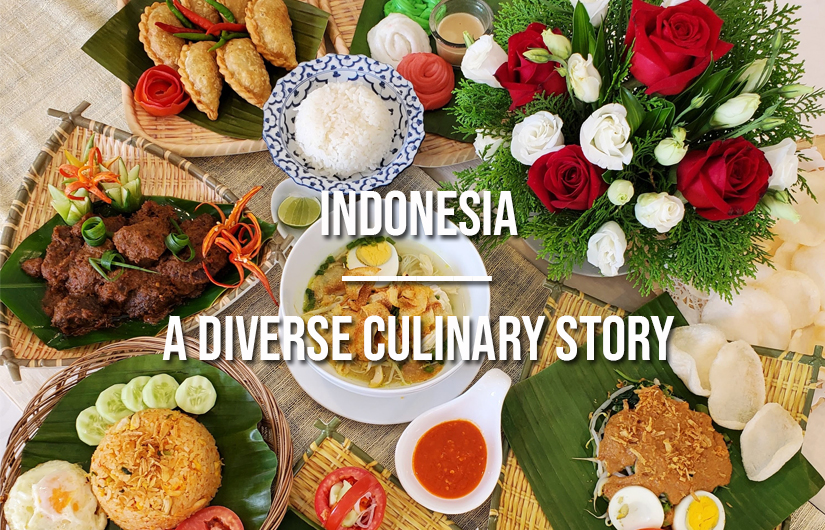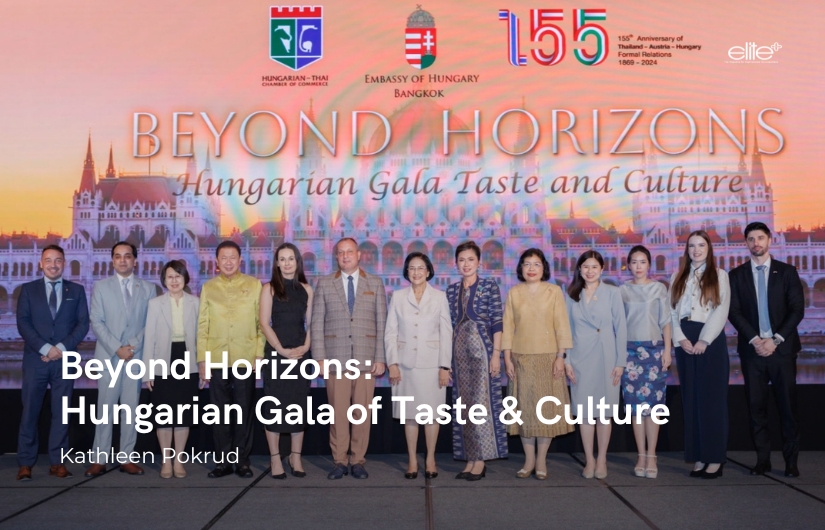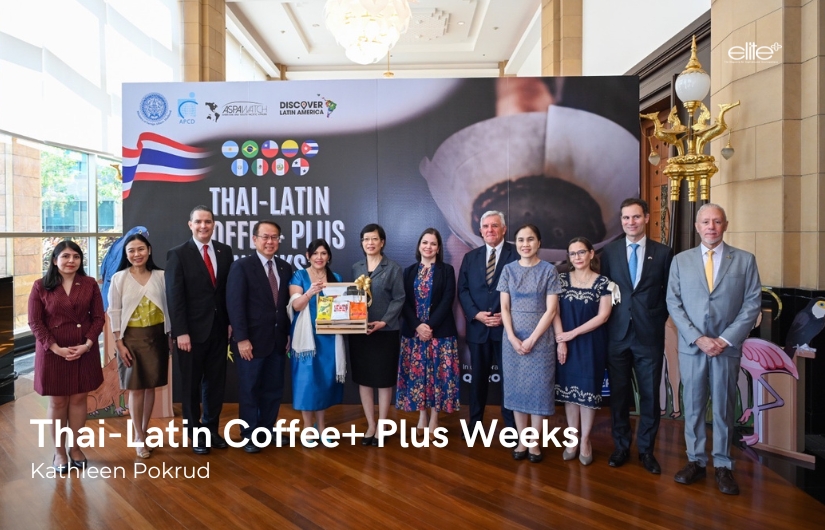I was quite delighted when I learned that Kathleen Pokrud would be writing this article entitled, "Indonesia: A Diverse Culinary Story". I believe her travels in my country and partaking in local cuisines in different parts of Indonesia will enable her to describe the richness and uniqueness of Indonesian cuisine from a foreigner's perspective.
Readers should find some insight into the country's culinary culture, showcasing the diversity and complex flavours of Indonesian dishes. The article not only offers readers an enchanting collection of Indonesian foods and cooking styles, but also delves into the historical role of food in each region’s culture. The recipes are accompanied by detailed explanations of ingredients and techniques as well as discussions of their development over time. Filled with beautiful photography, this article captures most of the aspects of Indonesia’s diverse culinary culture and represents a lifetime of research into both traditional and modern cooking methods.
I am sure this article will serve as a great source of knowledge for those who love to explore and appreciate the culinary heritage of Indonesia. It will also serve as a reference for people who are interested in learning about the unique and delicious flavours of Indonesian cuisine.
Therefore, I would like to convey my deep appreciation to Kathleen for her tremendous efforts and determination in putting together this information and stories about the Indonesian culinary culture. I appreciate her passion in sharing her knowledge about the cuisines of different countries, including Indonesia.
It is my hope that this article will both educate and entertain those interested in cuisines and cultures.
.jpeg)
Rachmat Budiman (Ambassador, The Embassy the Republic of Indonesia)
As the largest country in Southeast Asia, Indonesia is a very diverse society with a long history. This heritage strongly influences the diversity of its culinary story. Many regional cuisines exist, often based upon indigenous culture with some foreign influences. Indonesia’s food culture cannot be separated from the country’s extended history. With the support of the Indonesian embassy, I have led two different ladies’ group for the educational visit in 2018 (International Women’s Club of Thailand) to Bali and Yogyakarta; and in 2019 (Hong Kong Ladies’ Group) to West Sumatra. The regional differences in the local cuisines are significant. I was invited by Madame Tanty R. Budiman, spouse of HE Rachmat Budiman, Ambassador of The Embassy of the Republic of Indonesia to the Kingdom of Thailand to learn about the complexity and distinction of Indonesian dishes.
.jpeg)
Indonesian cuisine often demonstrates complex flavour, acquired from certain ingredients and seasoning spices mixture. Indonesian dishes have rich flavours; most often described as savory, hot and spicy, and combination of basic tastes such as sweet, salty, sour and bitter. Most Indonesians favour hot and spicy food, with its sambal, the Indonesian hot and spicy chilli sauce with various optional ingredients, notably shrimp paste, shallots, and others, is a staple condiment at all Indonesian tables.
.jpeg)
On the question of the history of Indonesian cuisine, Madame Tanty quoted the Indonesian author of “Indonesian food culture mapping”, “Serli Wijaya categorized the culinary development in Indonesia into at least three phases: original, multicultural, and contemporary. Each phase has different ways on how the food is being prepared, being presented, or served, and being consumed or eaten which, in turn, shapes a strong basis for the establishment of the Indonesian food culture. This food culture is learned, shared, and passed from one generation to another and whilst some food ways have been refined and adapted, the majority are still applied until today.”
Explained in more detail, “The original culinary phase was during the periods of the great Indonesian kingdoms. The food culture in this period reflects how indigenous people undertook food-related activities ranging from food acquisition and preparation to food consumption without the influence of other nations. The following multicultural culinary phase was characterised by the influence of cooking art brought by traders from Europe, India, Middle East, and China. The arrivals of these traders had a significant influence on the food culture of Indonesia, particularly Dutch culture given the fact that they colonised the archipelago for more than 300 years. Now, the contemporary culinary phase is when the food habits of Indonesian people are influenced by the rapid development of global food service chains. Further, as an impact of globalisation, restaurants that offer so-called ‘modern’ international cuisines such as Japanese, Thai, Indian, and French have grown dramatically in the country, both operated by global and local business players. However, this trend was not aside from the popularity of Indonesian cuisines, Indonesian food is not just sold at local food street hawkers, but there are growing numbers of medium-large scale restaurants which specialise in the traditional Indonesian food.”
On the popularity of Indonesian cuisine around the world, Madame Tanty proudly shared, “Three of the Indonesian dishes have been recognized by CNN as being among the World's Most Delicious Food. In 2011, Rendang, the scrumptious meat dish from West Sumatra, was crowned the Best Food in CNN’s World’s 50 Best Foods. Once again, in July 2017, Rendang was number 1. This time, second to Rendang on the top was Nasi Goreng, Indonesia’s renowned and beloved Fried Rice. Indonesian satay also took 14th spot on the CNN World’s 50 best foods list. This surely confirms Indonesia’s reign over the world’s best-loved cuisines.”
With its enormous geographic and cultural diversity, Indonesian cuisine is rich in variety and taste. Madame Tanty elaborated, “Indonesian cuisine can be classified based on six major islands across the country. Each has different food culture characteristics that are shaped by the natural conditions, history, and culture of the region. Firstly, Sumatran dishes are influenced by Indian and Chinese culture. Secondly, Javanese cuisine is strongly influenced by the island’s traditional kingdoms in Central and East Java. Also named as a royal cuisine, most of Javanese cuisine is considered relatively mild compared to other regions of Indonesia. Then there are Bali and West Nusa Tenggara (Lombok) cuisines. Since the vast majority of the population in Bali is Hindu, this religious belief has reflected greatly the way Balinese cuisine is prepared; for instance, beef is very rarely used whilst pork is more common. On the other hand, West Nusa Tenggara is a mixture of cuisines with Hindu’s influence) and a touch of Dutch influence in taste.”
“The cuisine from Kalimantan, the Indonesian region of Borneo Island, is appealing too. Its sweeping coastlines and many large rivers provide an abundance of seafood and freshwater fish used in the local dishes, a big percentage of Chinese community lives in the west of Kalimantan, and it is unsurprisingly that cuisine in this region is dominated by Chinese-related ingredients such as noodles, soy sauce, and pork. On the other hand, at the rest of the island, the cuisines have strongly influenced by indigenous Dayak food that uses more indigenous spices and fresh herbs. The last two significant regions are Sulawesi Island, which is known for the best sea produce in Indonesia; hence, its culinary taste has revolved around seafood cuisines. Lastly, seafood similarly defines the cuisines from Maluku Islands and Papua, which are drier.”
The traditional style of Indonesian cuisine can be found in feasts or ceremonies. One of the best examples is “tumpeng”. It is a form of a cone-shaped rice molded by woven bamboo surrounded by a variety of Indonesian dishes. The rice itself can be plain white rice, nasi uduk (cooked with coconut milk), or yellow rice (colored with turmeric). The surrounding specialties are vegetables, fried chicken, beef stew, fried prawns, sliced omelette, potato cakes, corn cakes, fried chili sauce heart, and others. Tumpeng comes from the indigenous customs and beliefs of the Indonesian people who glorify the mountain as the abode of gods or ancestral spirits. It may be seen as the "Indonesian version of the birthday cake".
Key representative Indonesian dishes
In 2018, the Ministry of Tourism of the Republic of Indonesia has chosen 5 national dishes of Indonesia; they are soto, rendang, satay, nasi goreng, and gado-gado.
Soto is a catchall term for traditional soups, whether clear or infused with rich coconut milk. It is considered comfort food; every region in Indonesia makes soto in their own way using different types of meat, vegetables, and spices.
.jpeg)
Rendang from Padang, West Sumatera is widely popular not only in its originated province but also overseas. The main ingredient of this dish is meat, which is cooked in coconut milk and authentic spices like ginger, galangal, turmeric leaves, lemongrass, garlic, shallots, and other spices over an average of eight to nine hours. West Sumatra has at least 150 versions of the dish, and almost every village has its own version and what they have in common is their caramelized nature.
.jpeg)
Satay
Sate or satay seems to be a simple dish of skewered meat marinated with spices and then grilled. Indonesians can argue for hours over which is the best version.
.jpeg)
Nasi goreng
Nasi goreng or fried rice is a way to make use of leftover rice. Often mixed with meat and vegetables, it is a complete meal that is both satisfying and highly adaptable to local tastes. While there is a bewildering variety of nasi goreng across Indonesia, a distinguishing feature of Indonesian fried rice is its dark brown colour from the liberal use of sweet soya sauce.
.jpeg)
Gado-gado
Gado-gado can easily be found across Indonesia with different style depending on the region. It is one of Indonesian comfort foods in the form of a salad of raw, slightly boiled, blanched or steamed vegetables and hard-boiled eggs, potatoes, fried tofu and lontong (rice wrapped in a banana leaf), served with a peanut sauce dressing.
As our interview draws to a close, my final question is how Indonesian cuisine has changed over the years. Madame Tanty openly admitted, “Yes, it has evolved over the years, from the ancient kingdom, the colonization era, to the modern time. Javanese inscriptions dated from the 10th to 15th centuries mentioned some foods, which are identified with current Javanese food such as rawon (dark beef soup, pecel (mixed vegetables with spicy peanut sauce), and krupuk (crackers). By the 13th to 15th century, coastal Indonesian politics began to absorb culinary influences from India and the Middle East, as evidenced with the adoption of curry-like recipes in the regions of Aceh, West Sumatra, and Malay Peninsula. Chinese immigrants introduced stir-frying techniques with the use of Chinese wok. European colonialism was established in the 19th Century in the Dutch East Indies, and with it, the influence of European cuisine, notably the Portuguese and Dutch.”
.jpeg)
.jpeg)
“In this modern era, traditional Indonesian cuisine is still growing and developing and occupies a special place in the hearts of Indonesian people. Some changes that might occur are more flexibility in cooking the food itself, for example rendang, maybe some households don't use coconut milk which is actually obtained from grated old coconut but uses instant coconut milk which is more practical. In addition, with the invention of modern cooking utensils, this will also make a significant change in cooking traditional Indonesian food. However, many people still maintain the traditional way of cooking and serving food in addition to maintaining the taste as well as to maintain the culture and uniqueness of the cuisine itself.”
.jpeg)





















































































































































































































































































































































































































































































































































































































































































































































































































